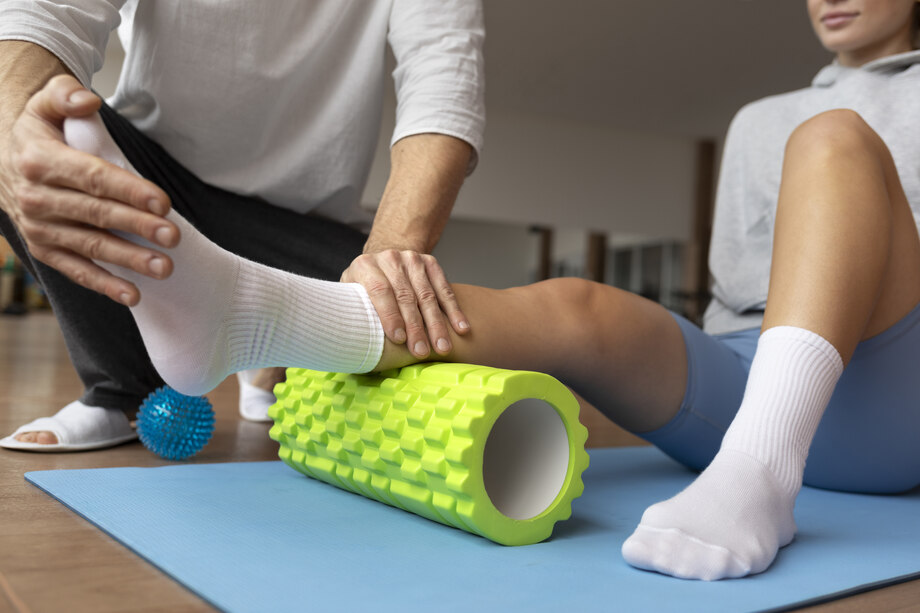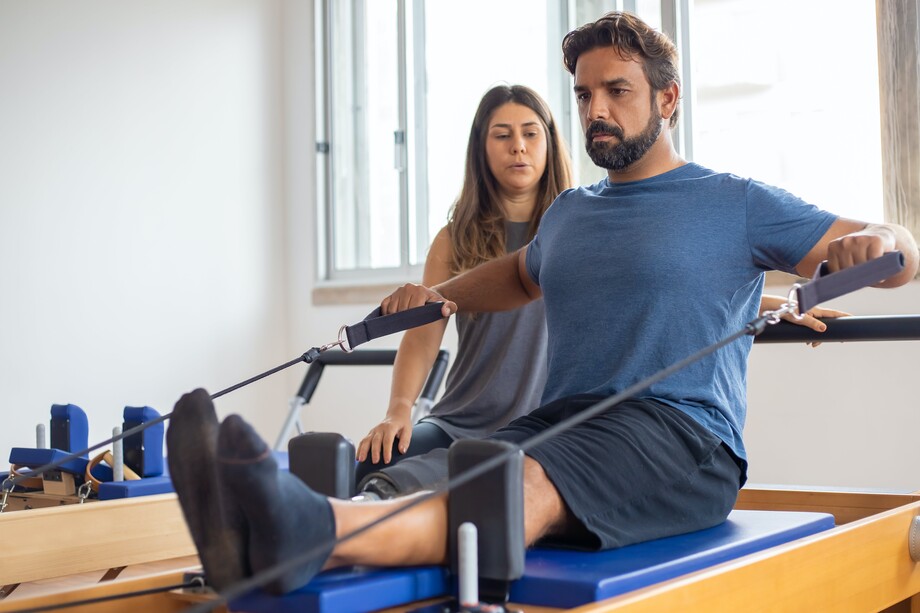We test and review fitness products based on an independent, multi-point methodology. If you use our links to purchase something, we may earn a commission. Read our disclosures.
A certified athletic trainer is someone who is educated and licensed to treat athletes in a variety of capacities, from sport-related injuries to emergency care needs.
If you’re interested in working with athletes—from professional sports teams to performing arts organizations to high school athletes—this career path might be for you. In this guide, we explain how to become an athletic trainer, as outlined by NATA.
RELATED: Best Personal Training Certifications
What Does an Athletic Trainer Do?
The National Athletic Trainers’ Association (NATA) defines athletic trainers as “health care professionals who collaborate with physicians” and states that “The services provided by ATs comprise prevention, emergency care, clinical diagnosis, therapeutic intervention and rehabilitation of injuries and medical conditions.”
Commonly referred to as “athletic trainers certified” (ATCs), these professionals are experts in kinesiology, biomechanics, exercise physiology, human anatomy, and sports medicine as a whole.

Keep in mind: An athletic trainer is not the same as a personal trainer. A personal trainer is someone who works with individual clients or groups to help them reach fitness goals, such as improving their body composition or running a marathon. Personal trainers, while educated in exercise science, are not healthcare professionals and do not have training in healthcare administration, clinical evaluation, or other skills that an athletic trainer has.
RELATED: How to Become a Personal Trainer
1. Earn an Accredited Bachelor’s Degree
The first step to becoming an athletic trainer is earning a bachelor’s degree. Your degree must come from an accredited program by the Commission on Accreditation of Athletic Training Education (CAATE).
A bachelor’s degree from an accredited degree program—typically in an exercise science-related field—is the minimum educational requirement in 2023.
Coursework in an athletic training education program varies by specific program, but generally covers anatomy, physiology, pathophysiology, sports-related injuries and injury prevention, clinical evaluation, rehabilitation, and more.
According to NATA, these educational requirements must be fulfilled:
- Evidence-based practice
- Prevention and health promotion
- Clinical examination and diagnosis
- Acute care of injury and illness
- Therapeutic interventions
- Psychosocial strategies and referral
- Health care administration
- Professional development and responsibility
RELATED: Best Health Coaching Programs
2. Earn an Accredited Master’s Degree
Although a four-year degree is the current educational minimum, according to NATA, a master’s degree is soon to be an entry-level requirement.
The NATA website says “…it was recently decided by the AT Strategic Alliance that the minimum professional degree level will be a master’s, a change to be implemented within the next several years. More than 70 percent of athletic trainers hold at least a master’s degree.”

A master’s program expands upon the education you learned at the undergraduate level. If you are just starting college or still in high school, it would be wise to pursue a bachelor’s degree that fulfills prerequisites for a master’s degree in exercise science or a related field. This is because by the time you earn your bachelor’s, having a master’s may well be the new minimum education requirement.
A master’s degree program is also an option for individuals who earned a bachelor’s degree in an unrelated field. You will need to fulfill additional prerequisites that your undergraduate degree didn’t fulfill, and then go on to earn a master’s that allows you to sit for the board certification exam.
RELATED: Low-Impact Exercises for Post-Injury Training
3. Pass the Board of Certification (BOC) Exam
As you might’ve known or guessed, there is a certification exam involved in becoming an athletic trainer. It is called the Board of Certification Exam or BOC Exam.
This exam is comprehensive and it is the only recognized certification exam for athletic trainers. It’s accredited by the National Commission for Certifying Agencies (NCCA).
To sit for it, you must have either:
- Earned your CAATE-accredited bachelor’s or master’s degree, or
- Be in the final semester of your CAATE-accredited bachelor’s or master’s degree program and have received confirmation on your exam application by the program director that you will earn the degree.
RELATED: A CPT’s Take on NSCA Certifications
4. Apply for and Earn State Licensure
After passing the BOC exam, you can apply for state licensure. The requirements for licensure vary by state, so be sure to check with your state board to ensure you meet all of the requirements.
5. Complete a Residency or Fellowship
Now it’s time to gain some clinical experience. While this step is not a requirement to become a licensed athletic trainer—you’ll do that before you get to this step—completing a residency or fellowship is often a prerequisite for obtaining employment. In a residency or fellowship, you’ll complete a predetermined number of hours in clinical practice, supervised by a physician. Learn more about residency and fellowship training from the CAATE.
RELATED: What is ACE Certification? A Review of the CPT Course

6. Earn Continuing Education Credits
Athletic trainers are required to engage in continuing education in order to maintain their certification and license. The Board of Certification generally requires ATs to earn 50 continuing education hours every two years; however, this can change, so definitely stay up-to-date with the BOC to ensure you’re on track to meet requirements during each recertification cycle.
Individual states can set forth their own continuing education requirements as well. Maintenance of your credential also requires you to stay up-to-date on emergency cardiac care (ECC) and provide proof of a current ECC card at the time of renewal.
7. Become a Member of the National Athletic Trainers’ Association (Optional)
Becoming a NATA member provides ATs with opportunities for professional development, continuing education, advocacy, networking, and professional support resources. It’s not necessary to become a member, but you may find it helpful in your career. Membership dues vary by state and whether you’re a professional or student.
RELATED: Barbell Safety: How to Prevent Injuries While Working Out
8. Earn a Post-Professional Degree (Optional)
If you desire, you can also continue your professional education and earn a doctorate in athletic training. This path would be a good option for individuals who wish to teach or work in academia, or conduct scientific research related to athletic training.
How to Become an Athletic Trainer: Final Thoughts
Becoming an athletic trainer requires a serious commitment to the career path and many years of schooling. Currently, a bachelor’s degree from an accredited program is the minimum educational requirement, but a master’s degree from an accredited program will soon be the minimum requirement.
Additionally, ATs must pass the BOC exam to earn national certification, and apply for licensure with their state; state requirements vary. Continuing education is required to maintain your certification and license, and post-graduate professional programs are encouraged.
How to Become an Athletic Trainer: FAQs
Is an athletic trainer the same as a personal trainer?
No, an athletic trainer and a personal trainer are not the same. The educational requirements and job duties differ vastly. While an athletic trainer is a state-licensed professional who must complete an accredited degree program and works in conjunction with physicians, a personal trainer is someone who helps their clients engage in safe and effective physical activity to reach their health and fitness goals. Athletic trainers work in clinical settings or with sports teams, while personal trainers typically work in fitness centers or own their own businesses.
If you want to become a personal trainer, take a look at our guide to the best personal training certifications.
Is an athletic trainer the same as a physical therapist?
No, a physical therapist is not the same as an athletic trainer. Although both types of professionals work with injured individuals, the athletic trainer focuses on injured athletes. Additionally, physical therapists are qualified to work in a greater realm than injury prevention and rehabilitation. They work with individuals who have neurological and motor conditions, musculoskeletal disorders, chronic disease, cancer, and more.
How much do most athletic trainers make?
According to the Bureau of Labor Statistics (BLS), the median pay for athletic trainers in 2022 was about $53,800. This includes data from both full-time and part-time providers. The BLS projects job growth for ATs to reach 14% by 2032, which it says is “much faster than the average for all occupations.”
How long does it take to become an athletic trainer?
It takes at least four years to become an AT, but often longer. According to NATA, the majority of athletic trainers today hold a master’s degree, which is soon to become the new minimum requirement.
Further reading

We tested the seven best backpacks for runners—from trail running to packing for race-day essentials. Read more

In this Orgain protein powder review, we’ll highlight our experience with the product and dive into the brand to help you decide if it’s right for you. Read more

Looking to enhance your morning routine? Find out whether it’s time to swap out your basic cup of joe in our Everyday Dose Mushroom Coffee review. Read more

Since 1974, NordicTrack has created innovative exercise equipment for the home gym crowd. The NordicTrack Commercial S22i Studio Cycle is one of the most technologically-advanced bikes that the company has put out. In the past year, the S22i has received a facelift to include faster Wi-Fi connectivity, improved HD graphics, and enhanced automatic trainer control.The S22i impresses with expansive interactive programing, adjustability, and an inertia-enhanced flywheel to create a smooth riding, quality exercise bike. The NordicTrack S15i, the brand’s other indoor cycle bike in this line, has similar features to the S22i but has a smaller screen and fewer resistance levels.When I test exercise bikes, I consider the footprint, assembly, durability, and overall workout experience. In this NordicTrack S22i review, I’ll give you all the information on what I liked and what you should know if you’re considering buying it.My Favorite Things22” rotating HD touchscreenFree year membership to iFit24 digital resistance levelsOffers incline and decline trainingMy CalloutsNot easy to move solo (203 pounds and bulky)Pricey at around $2,000Time-consuming assembly with many partsPaid subscription required to use iFit Read more

